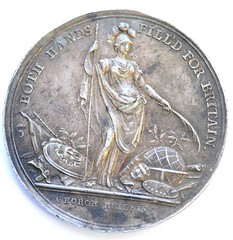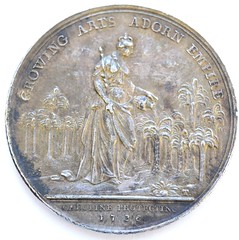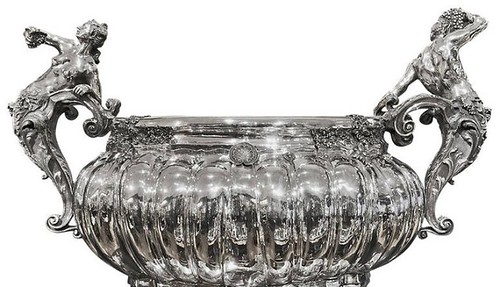
PREV ARTICLE
NEXT ARTICLE
FULL ISSUE
PREV FULL ISSUE
MORE ON JERNEGAN'S LOTTERY MEDAL  In the Numismatic Nuggets section last week I asked about this interesting medal, wondering what "Jernegan's Lottery" was about. First, here's the description of
the medal. -Editor
Silver Medal 'Jernegan's Lottery 1736' by J Tanner; obv. 'BOTH HANDS FILL'D FOR BRITAIN' around helmeted figure of Minerva standing between military trophies & emblems of the Arts & Sciences, 'GEORGE REIGNING' in ex., rev. 'GROWING ARTS ADORN EMPIRE' above crowned standing figure of Queen Caroline watering a grove of palm trees, 'CAROLINE PROTECTING 1736' in ex. Jim Duncan of New Zealand writes: He was a silversmith in London. He built a massive silver wine cooler - probably big enough to hold an adult, and offered it as a lottery prize. If you bought a ticket you got a medal as well. The original is now in Russia, but the Victoria & Albert Museum in London has a replica. I have seen it, but don't have a photo to share. Thanks! As it turns out, there were three electrotype copies of the wine cooler made and one was offered for sale last year. Here's a LinkedIn Pulse article by Silver Specialist
Anthony Mammon posted March 21, 2016. -Editor
 FOR SALE: A monumental European sterling silver, massive wine cistern, after the original made by C F Kandler, London 1735. The original was commissioned by Henry Jerningham, a London goldsmith-banker, who wanted to create the largest ever piece of entertainment silver. He employed the sculptor John Michael Rysbrack to model the Bacchanalian scenes on the bowl, the crouching panthers beneath and the satyr handles. It took the silversmith Charles Frederick Kandler four years to make. When it was finished in 1735, it weighed 8,000 ozs. In 1737 Jernegan offered the cooler as a lottery prize to raise funds for a new bridge over the Thames at Westminster. Silver medals were sold as lottery tickets for about five or six shillings each. The winner, Major William Battine, appears to have sold the cooler to the Regent Anna Leopoldovna of Russia in 1738. Since 1743 it has been in the Hermitage, St Petersburg. In 1857 the Victoria and Albert Museum made an agreement with Elkington & Co., the Birmingham manufacturers. Exploiting their new technique of electroplating, historic silver was reproduced 'increasing the copies of fine specimens' that not only the consumer may become familiar with the beauties, but both artist and artisan may also be able to compare the same with their own productions.' The scheme was so successful that it was extended to other European collections, including those in Imperial Russia. The Jerningham wine cooler was one of about 200 examples of English silver in Russia to be electrotyped. There are 3 electrotype copies known to exist. One is in the Victoria & Albert Museum in London. The second is in the Metropolitan Museum in New York, and the third is in the Queen's Regimental Silver in England. To read the earlier E-Sylum article, see: Wayne Homren, Editor The Numismatic Bibliomania Society is a non-profit organization promoting numismatic literature. See our web site at coinbooks.org. To submit items for publication in The E-Sylum, write to the Editor at this address: whomren@gmail.com To subscribe go to: https://my.binhost.com/lists/listinfo/esylum All Rights Reserved. NBS Home Page Contact the NBS webmaster 
|